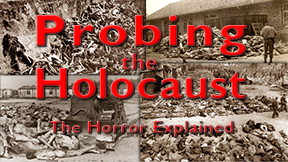According to orthodox historiography, which is prescribed by penal law in many European countries, about three million European Jews were murdered in homicidal gas chambers between December 1941 and the autumn of 1944. These chambers are said to have been erected in six camps in Poland, in the combined “concentration and extermination camps” Auschwitz-Birkenau and Majdanek (Lublin) and in the “pure extermination camps” in Bełżec, Chełmno (Kulmhof), Sobibór and Treblinka.
Revisionist historians contest this, however. They insist that there is no documentary or material evidence for this assertion. In a series of studies, they have provided evidence based on documentation as well as archaeological-forensic and technical evidence,
- that the alleged homicidal gas chambers never existed in these camps,
- that it would have been technically impossible to burn the alleged quantities of corpses as claimed in crematoria or on pyres,
- that there are no traces of mass graves of the necessary size,
- that the alleged casualties of these camps were, and still are, greatly exaggerated, and
- that the existence of a National Socialist plan for the systematic murder of European Jews cannot be proved.[1]
In essence, there is no dispute as to the fact that well over two million Jews have been deported to the aforementioned camps. If one assumes, as a working hypothesis, that the deportees in these camps were not murdered, the question arises: what else happened to them?
Revisionists posit that the six camps mentioned functioned partially (Auschwitz, Majdanek) or exclusively as transit camps, where the mass of deported Jews stayed only very briefly and then was deported further to the east. This is also Werner’s first hypothesis, as he explains at the very beginning. Over the years, several revisionists have tried to substantiate this thesis.[2] They have shown that this transit-camp hypothesis is fully in line with the documented policies of the Third Reich toward the Jews, as reflected in official and internal reports, documents on Jewish transports, and even in classified exchanges among leading SS members.
However, orthodox historians insist that the terms dominating in these documents, such as transit camps, eastward migration, resettlement, and evacuation, were merely part of a code language used by those in charge of the Third Reich to avoid documenting the ugly, if not highly criminal, reality of mass murders, in order not to create evidence against themselves. Although such tactics are likely to be used by hypothetical mass murderers, the absence of documentary evidence for the mass murder is certainly no proof for it, but rather against it.
While orthodox historians struggle to explain where the corpses or their remnants are that resulted from the mass murder they postulate, the revisionists face the challenge of proving where the Jews went.
There can be no doubt that the deportation of millions of people would have left distinct traces. Even if one assumes that the archives, especially in the former Soviet Union, have been cleansed of all sorts of “inconvenient” documents, it is to be expected that other documentary traces have been preserved. In addition, there should be a multitude of testimonies attesting to the arrival and presence of deported Jews in the occupied eastern territories. It is also to be expected that these settlement activities left material traces as well.
In three lengthy papers published in 2010/2011, Swedish revisionist Thomas Kues put together all the evidence that had been found in support of the revisionist thesis, adding a long list of new evidence to this already substantial list (Kues 2010a&b, 2011).
For many orthodox historians, the revisionist transit-camp hypothesis is a tremendous provocation that they usually ignore studiously. In December 2011, however, five orthodox researchers published a 570-page response to the revisionist thesis (Harrison et al.). This, in turn, triggered a massive response from the criticized revisionist researchers, which was published just two years later, in October 2013, in a two-volume work of nearly 1,400 pages (Mattogno/Kues/Graf).
In the present context, it is of particular interest that on this occasion Thomas Kues and Carlo Mattogno refined their arguments as first laid out in the above-mentioned books and articles, and substantiated them in 140 pages with further arguments and evidence (ibid., Chapter 7: “Where They Went: The Reality of Resettlement”, Vol. 1, pp. 561-703).
Reading these revisionist works on the subject makes one realize that the fate of those deportees who were deported to the East was not very rosy. Although they may not have been killed (“gassed”) in Bełżec, Chełmno, Sobibór or Treblinka, their lot in Byelorussia and other destinations was not necessarily much better, since accommodating these masses under humane conditions in these areas in such a short period of time and under wartime conditions was logistically impossible. The number of casualties must therefore have been terribly high for this scenario as well.
In spite of all this, orthodox historians still reject the revisionist hypothesis of transit camps. Some of them challenge the revisionists to show them one Jew, one single Jew, who was deported to one of the “extermination camps,” survived and then appeared further east. I responded to this challenge with an article that, in my view, meets this criterion: one single Jew. No, actually two (Rudolf 2017). Both cases were not discovered by me, but by Carlo Mattogno and Jean-Marie Boisdefeu. Here are the two cases:
Case No. 1, Discovered by Carlo Mattogno
A certain Minna Grossova, who was born on September 20, 1874, was deported to Treblinka on October 19, 1942 at age 68, at a time when on average about 5,000 Jews were allegedly killed and buried there every day. But instead of being killed there, she simply passed through Treblinka and from there was sent on to Auschwitz, of all places. At her age, she was certainly classified as “unfit for labor” by the usual selection on arrival and would therefore have been sent to the gas chambers, if the orthodox thesis were correct. But that is not what happened, because she was properly registered in the camp and died there only 14 months later, on 30 December 1943 (Mattogno 2016, p. 165).
If Mrs. Grossova was spared the gas chambers at Treblinka and Auschwitz at the age of 68 years, then why should many other not have shared the same fate? This fate also underlines that Treblinka was actually used as a transit camp in which not even old, infirm Jews were murdered. In any case, it is unlikely that Mrs. Grossova was the only deportee transferred from Treblinka to Auschwitz. Single transports for Jews in passenger cars did not exist at that time.
Case No. 2, Discovered by Jean-Marie Boisdefeu
This case is based on a memorial book published by a German government agency. It is about the Berlin Jew Siegmund Rothstein, born in 1857, who was deported to the Theresienstadt Ghetto in August 1942. However, just over a month later, on 26 September, he was deported to Treblinka at the age of 75. But this was still not his end, because the German authorities recorded another sign of life from him even further east: they determined that Rothstein had died in Minsk, the capital of Belarus. This city is located 286 kilometers east of Treblinka (Boisdefeu 2009, pp. 133-136).
I doubt that the 75-year-old Mr. Rothstein jumped off the train before arriving in Treblinka and drove to the German-occupied Minsk by himself. Therefore, he must have arrived there by train. I also doubt that the German authorities reserved a train just for him or simply took him to Minsk in a military train. He must have made this journey with hundreds or thousands of deportees from Theresienstadt on a deportation train.
This is by no means an isolated incident, for Boisdefeu states that none of the thousands of Jews deported from Theresienstadt are listed in the German memorial book as killed in Treblinka, but that they are all listed as having died or given their last sign of life at different places before any trace of them disappeared. This case also indicates that thousands of Jews were deported through Treblinka as a transit camp to the “East.”
But there were also deportations to the west that ran through Treblinka. On this, several eyewitness accounts of survivors exist which were recorded by orthodox organizations (Hunt, 6 min. 18 sec.). These witnesses confirm that they, along with hundreds of other deportees, were actually transited through the Treblinka Camp. Although these survivors were sent to the Majdanek Labor Camp rather than to the East, they confirm that Treblinka, at least in these cases, served as a transit camp for thousands of Jews.
It follows that Treblinka must in fact have had the logistics enabling it to temporarily – for a few hours or days – house, feed and clean hundreds, if not thousands, of individuals.
Research Desiderata
“These are just isolated cases,” claim our opponents. Sure, but so far nobody has systematically explored this issue. These isolated cases are all it takes, however, to undermine the dogma of the pure extermination camps irreparably. Apparently, Treblinka and thus probably also Bełżec, Chełmno and Sobibór were more than just extermination camps. What remains to be done?
- The thousands of survivor statements taken by various institutions should be systematically scanned for brief references to stays in the “pure extermination camps.”
- Government archives, media archives, museums and other historical collections in cities and towns in the areas considered to be destinations for deportations should be combed for documentary evidence of preparations for expected deportations or for deportees’ arrival and accommodation or any different treatment.
A few years ago, Thomas Kues decided to undertake a longer research trip to the deportation area in order to tackle the second desideratum listed above. However, he met with unexpected resistance, so that he not only had to give up this endeavor, but was also forced to withdraw completely from historical research at least temporarily. To this date, he has not sent us more detailed information.
In the present book, Steffen Werner took a different approach to at least partially unravel the mystery of the fate of Jews deported to the East. He wrote this book when the Soviet Union was in free fall. Werner expressed his hope that the policy of Glasnost and Perestroika initiated by Gorbachev would result in many files and archives that had previously been inaccessible would now be made freely accessible. This, he hoped, would make it possible to further substantiate his thesis that the Jews deported to the East were actually sent “into the morass” of Byelorussia, as Hitler put it.
Unfortunately, the archival spring of free Russia lasted only a few years. Due in part to pressure from the German government, the Russians and other Eastern European countries closed their archives again toward the late 1990s. Since then, independent researchers are no longer able to access these archives. Since 2014, it is moreover potentially punishable with up to five years’ imprisonment in Russia, as it is in Germany, to publicly disseminate theses as they are presented and substantiated here.
Werner’s second thesis is that the Jews deported during the war to the east “into the morass” should still be there today (meaning in 1990). I think that this thesis is somewhat naïve, for several reasons:
1. The Einsatzgruppen
As Werner mentioned several times, the German troops in the East were involved in a brutal partisan war. What Werner does not mention are the German counter-measures, especially the operations of the Einsatzgruppen and associated German units. Werner has an amazing blind spot here, because he does not mention the term Einsatzgruppen even once in his entire text.
According to the orthodox narrative, the Einsatzgruppen committed massacres in the East among the Baltic, Ukrainian, Belorussian and Russian Jews since the very beginning of the Russian campaign, and at least about one million Jews fell victim to them. Jews from other parts of Europe deported to the East are said to have gotten caught up in this maelstrom as well.
Revisionist texts on this complex see the activities of the Einsatzgruppen in a somewhat differentiated light, but even from their perspective it also becomes clear that the Jews in the East had to endure being scapegoated for the escalation of the war (see Rudolf’s “Concluding Remarks” to Siegert, pp. 550-555, as well as Mattogno 2018).
Under these circumstances, it is to be expected that some of the Jews deported to the East sooner or later ended up in mass graves, either because they joined the partisans and were executed as such by the Germans, because they were executed during reprisal killings for crimes perpetrated by – even that would have been legal under martial law, if it did not take on excessive forms (see Siegert) – or because they were “preventively” murdered with kith and kin as alleged bearers of Bolshevism and potential contributors to the partisans warfare. Irrespective of the legal evaluation of the individual actions, the fact remains that Jews deported to the East were by no means safe there, to say the least.
2. Stalin’s Policies Toward Deportees
After these areas had been recaptured by the Red Army, the Jews possibly deported to the East were still not out of danger, however. First of all, one has to keep in mind that no one was liberated who was conquered by the Red Army. The change of the ruling armies brought only a change of the oppressive system, but no liberation. In fact, large parts of the populations temporarily occupied by the German made it very clear by their voting with their feet what they thought about the Red-Army liberation propaganda: When the German units began to retreat, large swaths of the locals wanted to tag along with the Germans to the west but had to be prevented from doing so, because a trek of millions of westward migrants or refugees would have made German military operations impossible.
Although the Jews, as scapegoats of the National Socialists, were most likely to have felt liberated by the Red Army, Stalin was by no means a friend of the Jews as such. His mistrust of all sections of the population that had once been under German influence was so great (and mostly justified) that witch hunts set in on former collaborators in all the reconquered areas. Significant sections of ethnic groups that had collaborated particularly strongly with the Germans disappeared into Siberia. Inmates of liberated camps were not exempt from this, whether they were prisoners of war, labor or concentration camps or even ghettos. In particular, foreign elements with a Western-liberal background were considered suspicious at the time.
After the withdrawal of the Germans, the people who survived not only the deportation itself but also the actions of the Einsatzgruppen and the certainly poor living conditions “into the morass” saw themselves once more as targets of persecution and oppression. It may therefore be assumed that the number of surviving deportees who were still living in “the morass” when the Soviet Union collapsed was not high.
But even those who were allowed to stay in the deportation areas and later did not follow the general trend of moving to the West or to Israel in order to emigrate, eventually will have become a prisoner of the USSR, just like all other people in this totalitarian empire. Whether Jewish or not, whether deportee, displaced or local, the pressure of assimilation in the USSR at that time was great, and there was virtually no possibility for certain groups – here the former deportees – to organize themselves outside state supervision.
Under these circumstances, it would be almost impossible without help from the authorities or at least their acquiescence to track down survivors of that time or their descendants today. And with every year passing, this gets even more difficult.
In fact, not only is there no help or toleration from the authorities for such hypothetical research projects, but at best a visit from the public prosecutor, see above.
It is therefore not surprising that the earlier editions of this book were confiscated in 1993 by ordered of the Tübingen District Court and subsequently burned in waste incineration plants.[3] When facing such dictatorial conditions, historical scholarship can produce reliable results in this field of study only with the utmost exertion and with sacrifices.
Our thoughts are free, our thinkers are in prison or in exile.
Germar Rudolf
Red Lion, PA, March 10, 2019
Notes
[1] The first, cautious step in that direction was Rassinier’s book Drama of the European Jews, which is only of historical interest today. For recent research efforts see the many volumes of the series Holocaust Handbooks as listed at the end of this book.
[2] Cf. Enrique Aynat, Estudios sobre el “Holocausto”, Graficas Hurtado, Valencia 1994; Jean-Marie Boisdefeu, La Controverse sur L’Extermination des Juifs par les Allemands; 2 Vols., Vrij Historisch Onderzoek, Antwerpen 1996; Carlo Mattogno, Jürgen Graf, Treblinka: Extermination Camp or Transit Camp?, Castle Hill Publishers, Uckfield 2016; Carlo Mattogno, Thomas Kues, Jürgen Graf, The “Extermination Camps” of “Aktion Reinhardt”: An Analysis and Refutation of Factitious “Evidence,” Deceptions and Flawed Argumentation of the “Holocaust Controversies” Bloggers, Castle Hill Publishers, Uckfield 2013; 2nd ed. ibid., 2015. .
[3] Verdict of the Tübingen County Court, Ref. 15 Js 1608/93, with regard to Werner Steffen Werner, Die zweite babylonische Gefangenschaft: Das Schicksal der Juden im europäischen Osten, Selbstverlag, Pfullingen 1990/Grabert, Tübingen 1991 .







